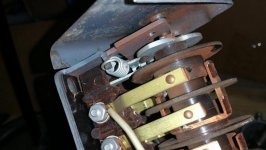I was curious what else was wrong, when you said it didn't work at all anymore in your initial posting, but I forgot. As long as the contacts meet, switch should work, even if not locking into position.
First check your supply voltage, make sure you didnt trip a breaker or fuse along the way.
If no, you could wire motor to the socket directly with breaker off, then bump breaker on to see if motor spins.
Looking at the wiring on switch, I was thinking single phase, but not 100%.
For me, 3 phase motors are easier to check. You could separate all the wires at motor and check resistance from 1 wire through all the rest, and to motor case. Do that to each motor wire, not the 3 phase leads, but the 9 or so motor wires. It should never be 0.0 ohms or a good connection, that would be a short. Though when you check across a mating coil wire you will read a higher resistance reading like 15 or 20 ohms.
Single phase can be a little different. Might have what I think is a capacitor, or some kind of can that looks like a hump or cylinder on motor case. I know they can pop, but haven't troubleshot them much, or single phase motors themselves.










